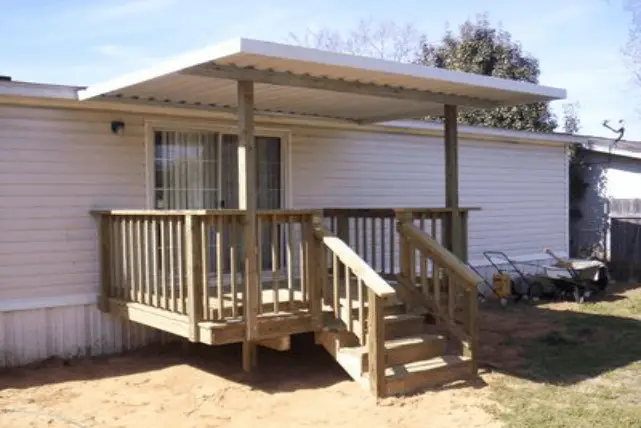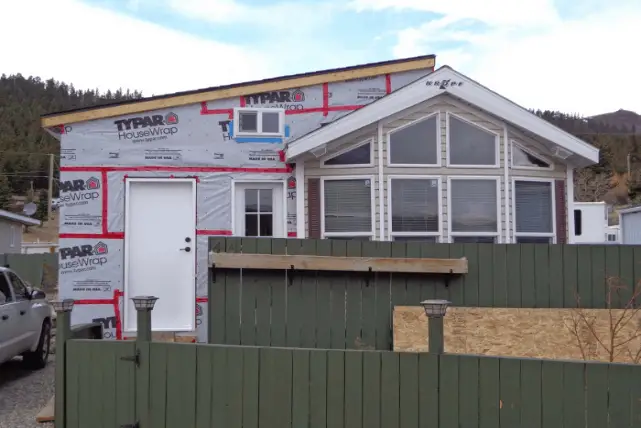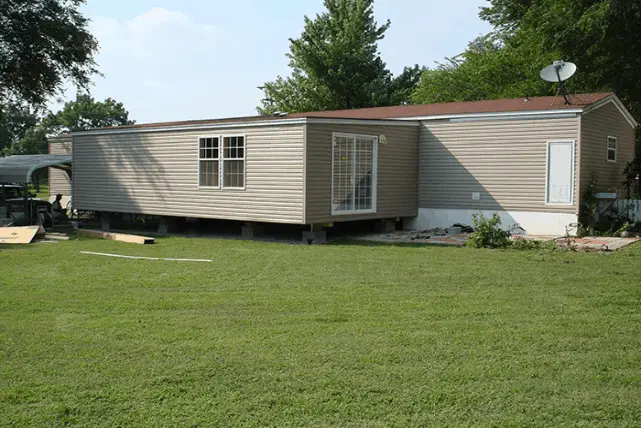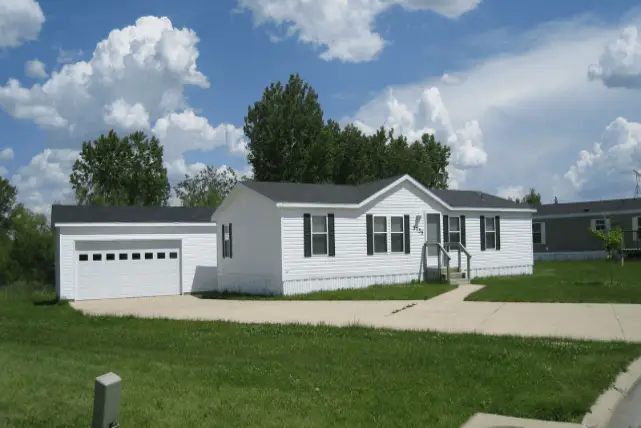At Mobile Home Friend, one of my responsibilities is to stroll through mobile home parks and neighborhoods, looking for a home that we can buy. Either for an investment rental or one to flip. I’m never surprised anymore by some of the “additions” I’ve seen built onto homes. But, are there HUD (Housing and Urban Development) rules that have to be followed?
Table of Contents
The Short Answer
In a word, “no”! There aren’t any HUD regulations that must be followed when putting an addition onto a mobile home. Manufactured homes built in factories must be built to HUD standards during construction. But at the end of that construction, each home is inspected and approved by an In-Plant Primary Inspection Agency (IPIA). When approved, the home receives its HUD label and is on it way to the homesite.
There are also some HUD standards that must be adhered to during the installation of the home on the homesite, but once the home is set up; HUD no longer has any jurisdiction over the home.
So, There Aren’t Any Standards For Building Mobile Home Additions?
Whoa, not so fast partner! When building any addition onto the mobile home, the local building codes must be followed. But, if you drive through manufactured home subdivisions or especially older mobile home parks, you’ll certainly catch an eyeful of home additions that you can tell didn’t pass anyone’s code just by looking at them.
There are some pretty good reasons why local building codes exist; mainly for the safety of anyone who may enter or occupy any structure or dwelling unit. Let’s quickly explore some of the things that must be taken into consideration when you’re thinking of adding a mobile home addition.
Concerns About Mobile Home Additions
Mobile homes, especially a single-wide, are generally smaller than site-built homes. As needs change, many manufactured home owners think “I’ll just build on an addition for that extra room; nobody will ever know”!
Wrong! People always know. When draftsmen draw up floor plans for manufactured homes, they are built
Safety First
Exits
Manufactured homes are built with a minimum of 2 exits. We have seen often where a room addition will be made and attached to one of the exit doors. This creates a grave safety concern in the event of any emergency.
Structure
HUD regulations require the outer walls and foundation system in a manufactured home to be engineered to withstand the weight of the roof and wind shear stress against the walls and roof of the home.
Manufactured homes are not built to withstand the weight of any joined addition where that addition places any additional weight or stress on the roof, walls or foundation.



Wiring
When mobile homes are manufactured they are wired specifically for the features the home comes with from the factory. The electrical boxes on the homes are not meant to have added electrical circuits. Often a DIY addition will tap into another circuit in the existing electrical box creating a hazard. This violates not only the original HUD standards of the home, but most likely local building codes was well.
HVAC Systems
In a previous post, “How Can I Tell If My Mobile Home Air Conditioner Is The Right Size?” we discussed the need to match the size of the HVAC system to the size and layout of the home. When additions are built on, they often have an added vent from the existing ductwork for the original home. This will completely change airflow through the home and place additional stress on the system.
Crawl Space
Most manufactured homes sit up off the ground and rest on a pier type foundation. Skirting is used around the home, not just to make the home more appealing, but also to protect the underside of the home against animals and excess water and moisture.
The skirting around the home is required to have a certain amount of venting for every so many square-
If Your Home Is Under Warranty – An Addition May Cause It To Be Voided
Warranties are a big deal. Why do millions of Americans buy extended warranties for everything from small appliances to automobiles and homes? Because if needed, repairs can be very expensive.
Manufacturers build homes to required standards. This means that the roof, walls, floors, and foundations are engineered to exacting standards. Probably the most common addition is that of an awning or carport which is usually attached to the roofline of the home.
This can actually void your warranty unless the home was built with the awning specification when ordered. We have purchased new manufactured homes to be placed on land where we’ve torn down older homes. When ordering, we always make sure to have the home built with the options for awnings to be attached.
Moving A Home If Additions Are Present
It is already a major undertaking just to move a manufactured home to a new location. See our post “How Much Does It Cost To Move A Mobile Home”?
If additions are present, they will not be able to be moved with the home and must be removed prior to prepping the home for transport. Often, DIY home additions are built in such a way that damage to the home is generally the result and make the additions very difficult to remove. If any doorways, plumbing or wiring have been modified they will need to be restored back to the original condition.
Ok, Ok, But I Still Want To Build An Addition To My Mobile Home!
Homeowners of all types like to customize their homes. As people, we all like to be unique and make our space something that is personal to us and our way of living. With mobile home living, owners often want to build covered patios or porches, have storage rooms, or even a garage.
When a manufactured home is built, it must adhere to HUD standards. But as stated above, HUD does not regulate any additions to the home after it has been delivered and set up. If an addition is required to create the home of your dreams, then go about it the right way. Any mobile home addition must adhere to the local building codes. This often means researching what those codes require and then submitting plans to the municipality and passing inspections at various stages through the construction.
This is often beyond the scope of what most DIY types are comfortable with or able to do. Unless the above paragraph sounds like a “good time” you may be better off hiring a professional to do the job for you.
Building That Manufactured Home Addition
FEMA (Federal Emergency Management Agency) recommends that “homeowners would never add a structure to their home that the home is not designed to support. If a homeowner wants a carport or porch, the mobile home addition should stand apart from the home and structurally support itself”.
The biggest mistake we see when homeowners built additions onto their homes is structurally attaching the addition to the home. Previously we have mentioned many times that the homes are not engineered from the factory to support anything other than their own weight. Attaching porches and decks, carports and garages can add significant stress to the structure of the home.

This is why each addition must be built to support its own weight. Rather than structurally attaching a deck to the home, the deck should be built so that its support posts are completely separate from the home. The same goes for any covered patio or porch.
Garages should be built so that they are not in actual contact with the home, but that space exists between the two.
Related Questions
“Are Mobile Home Wood Decks Dangerous?”
Most manufactured homes sit up off the ground with steps leading up to the doors. This often can make the home feel isolated from the outdoors. An elevated wood deck is a valuable addition to any manufactured home if it is built properly, but can be dangerous if it isn’t! How can you tell the difference?
Many mobile home decks are DIY weekend projects for homeowners. While the owner may mean well, there are simply millions of decks that are not built to local building codes.
Outdoor wooden decks are directly exposed to the elements and have a much shorter expectancy than the rest of the house. Because many decks are not built to professional standards and the materials are prone to rot, many mobile home outdoor decks are dangerous and in need of rebuilding or repair.
“Should You Remodel An Older Mobile Home?”
Older manufactured homes are far less expensive to buy than a new mobile home, and a fraction of the cost of a site-built home. Whether you plan to live in the home, flip it, or buy it as a rental investment, does it make sense to invest money into an older home?
At Mobile Home Friend, our answer to this question is a RESOUNDING “YES! We have done this with homes that were given to us, homes that we paid less than $1,000 for and homes that we’ve paid up to $10,000 for. We’ve yet to lose money on any of them! We will caution that if the home is a pre-HUD (built prior to June 1976) it may not be the wisest choice.
That said, approach remodeling any mobile home with CAUTION! There are lots of things to look out for in making the decision on how much remodeling you should do.
